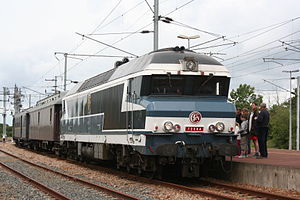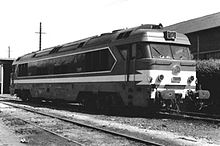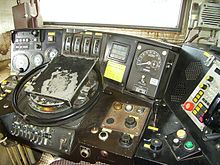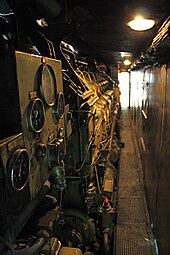SNCF CC 72000
| CC 72000 | |
|---|---|
|
CC 72084 in Lison station
|
|
| Numbering: | 72001-72092 |
| Number: | 92 |
| Manufacturer: | Alsthom , SACM |
| Year of construction (s): | 1967-1974 |
| Axis formula : | C'C ' |
| Gauge : | 1435 mm ( standard gauge ) |
| Length over buffers: | 20,190 mm |
| Trunnion Distance: | 11,990 mm |
| Bogie axle base: | 2 × 1608 mm |
| Service mass: | 114 t to 118 t |
| Top speed: | 85 km / h to 160 km / h |
| Continuous output : | 2,250 kW |
| Driving wheel diameter: | 1140 mm |
| Motor type: | SACM AGO V16 |
| Motor type: | 16 cylinder diesel engine |
| Number of traction motors: | 2 × type TAO 656 B1 |
| Drive: | diesel-electric |
The CC 72000 is a series of diesel-electric locomotives from the French national railway company SNCF . The six-axle machines initially used in the express train service and later also in the freight train service are the most powerful diesel locomotives of the SNCF. The design known as “ Nez cassés ” (broken noses) was not used in any other diesel series.
prehistory


The first line diesel locomotives of the SNCF from the 1950s and 1960s were not an adequate replacement for the steam traction . Their performance did not suffice to pull express trains with a weight of 850 tons and freight trains weighing 1500 tons. In addition, the use of the train heating on cold days reduced the engine output - and thus the speed - noticeably. The diesel- electric series CC 70000 was therefore designed as a heavy diesel locomotive to replace steam locomotive series such as the 241 P. Their output of 3230 kW was achieved by installing two diesel engines. It was left with two unique pieces, as more powerful engines were developed at the time, which made it possible to build single-engine machines with sufficient power.
The CC 72000 was created against this background, and experience gained in the development of the Finnish Hr13 series could be used.
History and commitment
The CC 72000 locomotive series was commissioned in December 1965. The outer shape is based on that of the CC 40100 series , the design comes from Paul Arzens . In contrast to the French standard, the machines were given a switchable third top light for cross-border traffic to Germany and Switzerland . On April 12, 1968, the pre-series machine CC 72002 arrived in Grenoble for test drives on the Ligne des Alpes to Veynes . The first serial machine was put into service in Rennes in December 1970 , the last in June 1974 there. Nineteen of the first twenty locomotives (72001 to 72016 and 72018 to 72020) were designed for a top speed of 140 km / h, with the 72017 and the machines from 72021 it was increased to 160 km / h. As a result of the first oil crisis , no further locomotives of this series were ordered after 1973.
The CC 72000 were used by the Rennes, Chalindrey , Vénissieux and Nevers depots. They were designed for use in front of express trains on non-electrified routes and operated mainly on long routes such as Quimper - Toulouse or Lyon - Bordeaux . From the Gare de l'Est station in Paris , they pulled the Trans-Europ-Express Arbalète via Belfort and Mulhouse to Basel . CC 72,000 also came from Valence via Grenoble to Geneva , Switzerland. The cross-country runs Grenoble - Nantes and Grenoble - Bordeaux were run without changing locomotives.
Eighteen of the slower 72001 to 72020 were handed over to the freight train service Fret SNCF and received its green livery. In 2013 they were retired or resold. Four of these machines (72003, 72009, 72018 and 72020), plus the faster 72027 and 72085, came to Morocco to the state railway company Office National des Chemins de Fer (ONCF). There they run under the company numbers DF 115 to 120.
Thirty of the 160 km / h fast locomotives received new engines and became the CC 72100 series . They were given a 1 as the third digit with the same serial number (digits 4 and 5). B. from 72021 the 72121. These are the machines with the order numbers 21, 30, 37 - 41, 43, 45, 47, 48, 51, 56 - 58, 60, 63, 66, 68, 72, 75 - 80, 82, 86, 89, 90.
Due to the high noise and exhaust emissions, the CC 72000 retired from active service relatively early. In addition, their performance in front of heavy express trains on the weekends was often insufficient. Then they were replaced by machines from the BB 67000 family coupled in pairs , which led to a reduction in top speed to 140 km / h.
In December 2009 the last regular assignments took place on the route Nantes - Tours - Lyon. On November 21, 2012, four machines from the CC 72000 series were still in use in France, three of which were based in Nevers . The 72049, 72074 and 72084 are kept as an operational reserve in the event of failures and can even reach Paris - under contact wire. The fourth locomotive is at the Supervision technique de flotte (STF) Champagne-Ardennes.
The 72186 was the last passenger train pulled by a 72100 on August 28, 2017.
description
The length over the buffers is 20,190 mm, the maximum width 2952 mm. The distance between the pivot pins is 11,990 mm, the distance between the wheel sets in the bogies is 1608 mm. The wheels have a diameter of 1140 mm. The service mass of the locomotive is 114.0 t, the largest wheelset traveling mass 19.9 t.
The originally installed SACM diesel engine of the type AGO V16 ESHR has an output of 2650 kW at 1350 rpm. By increasing the speed, even 2950 kW were achieved, but this was only used in the pre-series locomotives CC 72001 and 72002, which were ordered in December 1965. Using a three-phase generator and silicon rectifier, it drives a type TAO 656 B1 DC motor for each bogie, the locomotive has a continuous output of 2250 kW. The train heating is electric. The wheelset transmissions act on all wheelsets of the three-axle bogies, they can be switched to two speed levels. The slow speed level is a maximum of 85 km / h, the high speed level 140 km / h on the 72001 to 72016 and 72018 to 72020 machines of the first series. The following locomotives were up to 160 km / fast.
Special case CC 72075
In 1971, the Alsthom and Chantiers de l'Atlantique companies suggested that the SNCF equip a machine with the new Pielstick 12 PA 6 V280 motor. This 12-cylinder V-engine, already used in ships and power stations , promised an increase in output of 17% to 3090 kW. The aim was to offer it for export models, but the SNCF also showed interest.
The choice fell on the first locomotive of the last series with the CC 72075. Numerous changes were necessary, which delayed their delivery by six months: replacement of the inverter, adaptation of the cooling circuit, increasing the speed of the fans, replacing the silencer and adding a system to increase friction . Since the engine was turning more slowly at 1050 rpm, the auxiliaries had to be adapted accordingly. The mass increase of 1.7 t was mainly due to the AT7 alternator used .
From July 1973 the locomotive hauled 1,800 t freight trains between Rennes and Morlaix , where it replaced machines of the BB 67000 series used in double traction . At the end of that year it was used in front of fast passenger trains on the Paris - Nantes route , where it pulled two additional wagons with unchanged travel times.
In September 1974 the output of the CC 72075 was increased to 3530 kW at 1130 rpm, which corresponded to that of a BB 67000 double traction. Adjustments were necessary for this, including a. the addition of two coolers and another replacement of the generator. In October 1975 the machine took to the track, where it demonstrated its increased performance. The weak points were the lower average operating time of the engine and its fuel consumption. Nevertheless, the SNCF initially intended to purchase about ten such motorized locomotives for the Paris – Clermont-Ferrand connection. However, the economic crisis at the time moved them to cancel all orders for diesel locomotives.
The CC 72075 kept its engine and was used in front of heavy trains in Brittany and between Paris and Nantes until 1982. After problems with the engine in the second half of 1984 and the failure of the generator, it was temporarily shut down in August 1985. In the twelve years of her career she had covered 2.1 million km by then.

Together with the CC 72044, it became the test vehicle for the 16-cylinder Pielstick 16 PA 4 V200 VGA engine in June 1987, which was to be used in the planned BB 73000 series with asynchronous traction motors . The power of the diesel engine was initially 2355 kW, later it was increased to 2650 kW. In Chalindrey home she pulled the 1992/93 Arbalète between Paris and Switzerland. After engine problems in the period 1994 to 1997, it was considered in 2000 to install the standard AGO engine, which would have required too many dismantling. The possible use of the used motor of the CC 72044 also turned out to be ineffective. Finally, in April 2004, she received a second Pielstick 16 PA 4 V200 VGA, this time with electronic control and new turbo compressors. With the new company number CC 72175, it was in use until it was shut down in December 2012.
TGV deployment
After a TGV Atlantique train ran for the first time from Paris-Montparnasse station to Nantes on January 23, 1989, the demand for a high-quality connection for summer guests from Paris also arose in the coastal town of Les Sables-d'Olonne . The nearest electrified train station, however, was in La Roche-sur-Yon , 36 km from Les Sables-d'Olonne. Electrification of the railway line coming from there was out of the question for cost reasons, especially since tourist traffic was largely concentrated during the summer holidays. Therefore the idea was developed to let diesel locomotives pull the TGV on this end section.
A single locomotive of the BB 67400 series could have carried the train over the hilly route with numerous ramps of up to 10 ‰. However, their output of 1525 kW is not enough to supply the TGV with energy. The option of using two such machines in 34.18 m long double traction failed due to the insufficient usable length of the platform tracks in the terminus . Therefore, the CC 72000 was ultimately used.
In 1999 the buffers were removed from the CC 72061, 72062 and 72064 and Scharfenberg couplings were installed. The latter were modified for the passage of 1500 V direct voltage , and a Knorr air dryer was installed to supply the TGV . The three machines were given the new numbers 72101 to 72103. Under driver's cab 2, below the buffer beam, an emergency coupling was attached in a box so that the trains could be towed with a classic motor vehicle if necessary.
The eight TGV sets 372 to 379 were given couplings adapted accordingly for these missions. In Les Sables-d'Olonne, the track on the house platform was provided with a temporary overhead line so that the TGV could supply itself with electricity during the stay. The first TGV pulled by a CC 72000 reached the place in commercial traffic on May 28, 2000. Two such pairs of trains were on the road between there and Nantes 112 km away every day, and more on weekends and in times of high demand. The 1500 V connection of the Scharfenberg coupling proved to be the weak point, which could lead to failure of the air conditioning system and the locking of the entrance doors of the TGV. For safety reasons, a replacement service had to be offered repeatedly.
This type of operation turned out to be very deficit, which is why it was planned to end in December 2003. In fact, the last of these trains didn't run until twelve months later. Then the three machines were dismantled and numbered. They were among the last CC 72000 in service. The 72064 has been with the Association Rhône-alpine de Conservation d'Engins Thermiques (ARCET) since 2010 .
Others
- In the summer of 1972, CC 72000 operated on the Ligne des Alpes from Lyon via Grenoble and Veynes to Marseille. In the narrow, winding Grand Brillon Tunnel, the diesel engines tended to "choke" on their own exhaust gases.
- The 72006 locomotive was the only one of the series to receive the different Isabelle color scheme , and later it was repainted in the Fret colors.
- The CC 72029 is in the Cité du Train railway museum in Mulhouse.
- The CC 72084 has got its original livery back. It was in the Technicentre Auvergne-Nivernais repair shop until the end of 2012 .
- The DF 100 series (DF 101 to 114) delivered by Alsthom in 1968 in 14 units to Morocco differs only slightly from the CC 72000.
- In 1981, Sorefame delivered 13 very similar machines for heavy goods traffic to the state-owned railway company Comboios de Portugal (CP) under license , which were given the operating numbers 1901 to 1913 as the 1900 series . Its 1930 sister series , from which Sorefame produced the locomotives from 1931 to 1947 at the same time, was designed for use in front of passenger trains. Its top speed was 120 km / h compared to 100 km / h for the 1900 series.
Web links
- List of CC 72000 (French)
- CC 72000 SNCF at trains-europe.fr (French)
literature
- Thomas Estler: Locomotives of the French state railway SNCF . 1st edition. Transpress, Stuttgart 2014, ISBN 978-3-613-71480-9 .
- Howard Johnston, Ken Harris: Jane's Train Recognition Guide . HarperCollins Publishers, London 2005, ISBN 0-06-081895-6 .
- Georges Mathieu: Le matériel moteur de la SNCF . 1st edition. Editions La vie du rail, Paris 1984, ISBN 2-902808-48-8 .
Individual evidence
- ↑ a b Thomas Estler: Locomotives of the French state railway SNCF . 1st edition. Transpress, Stuttgart 2014, ISBN 978-3-613-71480-9 , pp. 82 .
- ^ Clive Lamming: Trains de Légende: Les Réseaux français et la Naissance de la SNCF (1938-1950) . 2006, ISBN 2-8302-2147-8 , pp. 36 f .
- ↑ CC 70000 SNCF at trains-europe.fr, accessed on March 3, 2018
- ↑ List of all CC 72000 (French), accessed on January 13, 2017
- ↑ Thomas Estler: op. Cit. , P. 83
- ↑ France: CC 72000 stored in: LokMagazin 11/2017, p. 31
- ↑ a b Retour au monomoteur avec la CC 72075 in: Ferrovissime No. 106, p. 44 ff.
- ^ Georges Mathieu: Le matériel moteur de la SNCF . 1st edition. Editions La vie du rail, Paris 1984, ISBN 2-902808-48-8 , p. 199 .
- ↑ a b Il ya 20 ans, naissait en Vendée un drôle de TGV in: Ferrovissime No. 105, p. 22 ff.
- ↑ Howard Johnston, Ken Harris: Jane's Train Recognition Guide . HarperCollins Publishers, London 2005, ISBN 0-06-081895-6 , pp. 217 .
- ↑ Howard Johnston, Ken Harris: op. Cit. , P. 28.
- ↑ Howard Johnston, Ken Harris: op. Cit. , P. 312.








